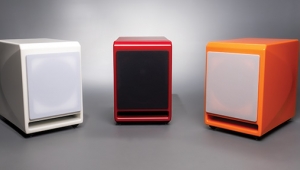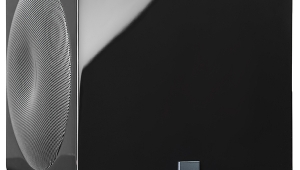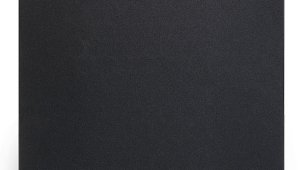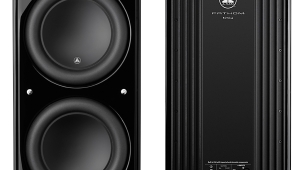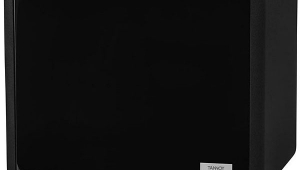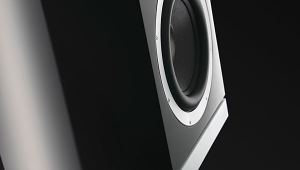| Columns Retired Columns & Blogs |
Velodyne Digital Drive DD-18 powered subwoofer
It's common to read ads for new audio hardware that crow about "revolutionary" breakthroughs in sound performance, and that's how Velodyne crowed about their new Digital Drive DD-18, servo-controlled, powered 18" subwoofer. The ads suggested that the DD-18 can be digitally equalized to one's room with a resultant in-room frequency response of 20-200Hz, ±3dB.
Footnote 1: Michael Lewis, The New New Thing. New York: W.W. Norton, 2000.—Larry Greenhill
 When I've tested other "breakthrough" subwoofers, I've been disappointed. All the convenient fine-tuning in the world won't matter if I end up with the same nasty old room modes and woofer bloat. But I'd been impressed when I'd reviewed Velodyne's earlier servo-driven 18" models: the ULD-18 (Stereophile, Vol.12 No.10), FRS-18 (Vol.21 No.8), and HGS-18 (Vol.22 No.10). When Curt Chisholm, the company's head of customer support, offered me the Digital Drive DD-18 to review, I jumped at the chance.
When I've tested other "breakthrough" subwoofers, I've been disappointed. All the convenient fine-tuning in the world won't matter if I end up with the same nasty old room modes and woofer bloat. But I'd been impressed when I'd reviewed Velodyne's earlier servo-driven 18" models: the ULD-18 (Stereophile, Vol.12 No.10), FRS-18 (Vol.21 No.8), and HGS-18 (Vol.22 No.10). When Curt Chisholm, the company's head of customer support, offered me the Digital Drive DD-18 to review, I jumped at the chance.
What's new
The DD-18 physically resembles Velodyne's HGS-18 ($3499). Like that and other earlier Velodyne subs, the DD-18 has a closed-loop, accelerometer-based, servo-controlled drive-unit—an 18" dual-coil woofer with a linear excursion of 1.25" peak-peak—a built-in electronic crossover and amplifier (1250W RMS, class-D, in this case), balanced and single-ended line-level inputs, selectable phase and volume controls, an onboard eight-band digital graphic/parametric equalizer, thermal protection, remote control on/off and volume presets, signal-sensing and polarity-inverting circuitry, and a low-line-voltage power cutoff. The DD-18 also has a limiter to prevent its amplifier from overloading. This operates in the digital domain, allowing it to track any signal, to play loud without overload, and to instantly reduce the gain if there's a massive input signal.
The DD-18 differs from the HG-18 in such subtle externals as its shinier cabinet with more rounded edges. The most evident difference is the increase in price, from $3499 to $4999, said to cover the DD-18's room-calibration system, a more sophisticated remote control, a precision calibration microphone, user interface software, and two years of research and development. The subwoofer is supplied with a microphone and stand, a 25' mike cable, and a 25' audio/video signal-generator interconnect.
To calibrate the DD-18 in the user's room, the subwoofer generates a swept tone that is detected by the microphone. The mike "listens" to the sub's output only at the specific frequency of the sweep generator's tone, this allowing it minimize the effects of room modes. The DD-18's software displays the sub's in-room response, from 20 to 200Hz, on a conventional TV set, along with the owner's adjustments to subwoofer equalization, phase, and crossovers in real time.
Technology
The DD-18's nearly cubical enclosure, made in China, measures almost 2' on a side and weighs 123 lbs. The cabinet is made of ¾"-thick MDF, and the unoccupied internal volume is just under three cubic feet. Internal bracing, silicon latex caulking, and corner blocks are added after the enclosure is sealed with epoxy to prevent air leaks, which weaken acoustic output. The DD-18 sits on four acoustically isolated feet of ¼" milled aluminum.
All electronics and connections are made to the rear service panel, on which are mounted the computer, crossover, switching amplifier, speaker-level inputs, and RS-232 data connections. One XLR connector receives the balanced LFE signal from the user's processor, while another accepts the microphone connector. There are eight line-level RCA jacks: a stereo input pair, an output pair, a "through" signal pair for a second daisy-chained subwoofer, and the EQ output pair from the signal generator. The controls that once appeared on the HG-18's rear panel now appear only on the DD-18's remote control.
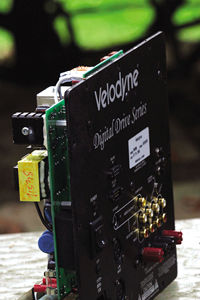 Internal electronics
Internal electronics
Just before I began this review, Velodyne notified me that my DD-18's high-pass crossover circuit had the wrong capacitor. They rushed me a new service panel attached to full set of new electronics (same serial number, later build date), and an illustrated replacement-procedure manual. Using this guide, I installed the new panel in two hours, and caught a glimpse of the DD-18's internal electronics.
A stack of three printed circuit boards is attached to the inside of the panel, the board closest to the panel holding the digital circuits, memory, and microprocessor. Two more boards sit on top, as in a three-layer cake. The built-in switching amplifier is attached to one of these boards; a thick shield of perforated metal prevents its radio-frequency emissions from reaching the adjacent A/D and D/A circuitry. The amplifier runs in class-D to achieve 95% efficiency, allowing the amplifier to output its full 1250W while remaining cool to the touch.
 The woofer occupies the rest of the enclosure. Its 18" cone is made of paper reinforced with carbon fiber, with a high-density surround and a linen spider. Four sets of five holes each punched in the cone break up standing waves and ventilate the voice-coil. The motor structure is capable of developing 100 lbs of force, and is almost as wide in diameter as the 18" cone itself. The motor uses a 24-lb magnet, two copper voice-coils, and two spiders. The voice-coils, one inside and one outside the former, are precisely wound in opposite directions onto the former, which is made of a woven-glass polyamide resin that is stable up to 400 degrees C. Although the driver's excursion has been increased to 1.25" from the HG-18's 0.75", the DD-18 can reach 1.75" on transients.
The woofer occupies the rest of the enclosure. Its 18" cone is made of paper reinforced with carbon fiber, with a high-density surround and a linen spider. Four sets of five holes each punched in the cone break up standing waves and ventilate the voice-coil. The motor structure is capable of developing 100 lbs of force, and is almost as wide in diameter as the 18" cone itself. The motor uses a 24-lb magnet, two copper voice-coils, and two spiders. The voice-coils, one inside and one outside the former, are precisely wound in opposite directions onto the former, which is made of a woven-glass polyamide resin that is stable up to 400 degrees C. Although the driver's excursion has been increased to 1.25" from the HG-18's 0.75", the DD-18 can reach 1.75" on transients.
The DD-18's High Gain Servo system uses a new voice-coil-mounted accelerometer. An ADC chip digitizes the control signal at the woofer cone, reducing noise in the servo loop system. The resulting bitstream is checked by system software up to 16,000 times per second, the corrections applied as indicated for better error correction and lower distortion. This is almost five times the correction speed found in previous Velodyne subwoofers.
 The new new thing
The new new thing
The DD-18's new new thing (footnote 1) is its built-in spectrum analyzer and eight-band digital equalizer, which allow the sub's performance to be optimized for its owner's listening room. (A handy TV set and the remote control are needed for this.)
A 16-bit A/D converter on one of the DD-18's printed circuit boards generates a digital datastream from the portion of the analog input signal below 200Hz. These data are subjected to low-pass crossover and equalizer functions by a Texas Instruments TMS320LF2407, a fixed-point digital signal-processing (DSP) chip that provides 30 million instructions per second of processing power. Following the DSP, the digital data are reconverted to analog for amplification. The program code for calibration and the user interface were written by Velodyne's David Hall and Bruce Hall using TI's Code Composer Studio Integrated Development Environment and debugger.
The DD-18 generates an NTSC composite-video signal to display three screens on your TV: Introductory, System Response, and System Settings. The Introductory screen shows the volume level, preset level, and code entry functions, the latter giving access to the setup controls when five numbers are entered via the remote's keypad. (My review sample responded to "12345.")
The System Response screen displays a frequency graph like one you might see in a spectrum analyzer, and automatically begins the 20-200Hz sweep signal. Initially, with the subwoofer at "0" volume, this showed my Quad ESL-989 speakers' audio output curve, rolled off below 80Hz (fig.1). Gradually increasing the subwoofer's volume allowed me to precisely match the DD-18's output level to the Quads' (fig.2). This screen also contains eight virtual sliders for room equalization, set at 20, 25, 32, 40, 50, 63, 80, and 100Hz. User adjustments and room calibration can be done in real time via the remote, as the display is continuously updated. System Response enabled me to set up the DD-18 quickly; it was the screen I used most often.

Fig.1 Quad ESL-989, high-pass-filtered in-room response (25dB vertical range).

Fig.2 Quad ESL-989 with Velodyne DD-18, in-room response (25dB vertical range).
Even with this multiplicity of functions, the DD-18's computer can store only one set of the eight equalizer level settings arrived at during setup. Velodyne considered storing different EQ room setups for each of its remote presets, but dealer feedback indicated that this level of complexity would confuse users. As a reviewer, however, I would have found it very useful to be able to store different settings.
The System Settings screen is used to store low-pass filter frequency and slope, subsonic filter frequency and slope, phase, polarity, subwoofer volume (1-99), contour frequency and level, Theater/Music, Auto On/Off, and Night Mode volume. Six complete sets of these settings can be stored, and passed along to any number of other Velodyne DD-18 units via an RS-232 cable. System Settings also has options for four factory-generated contours: Action/Adventure, Movies, Rock/Pop, and Jazz/Classical. Preset 5 is for user customization, and Preset 6 defeats all preset values on the System Settings screen to demonstrate the effects of custom settings.
 High-pass matters
High-pass matters
The DD-18's high-pass filter gently filters the signal to the main speakers at 6dB/octave below 80Hz. Unlike the filter in the HG-18, this one can't be switched off, which means it's impossible to view the full-range output of just the main speakers on the TV during setup. In addition, whereas the HG-18 offered the choice of 100Hz and 80Hz high-pass frequencies, this was omitted from the DD-18. Velodyne felt that a single 80Hz high-pass feed would suffice, given that most owners would use the DD-18 in a home-theater system in which its drive signal would be taken from the processor's Low Frequency Effects (LFE) output, which has no high-pass component. I was frustrated by this—I couldn't set the high-pass filter's frequency higher to limit low-frequency overload in my Quad ESL-989s.
Footnote 1: Michael Lewis, The New New Thing. New York: W.W. Norton, 2000.—Larry Greenhill
- Log in or register to post comments
